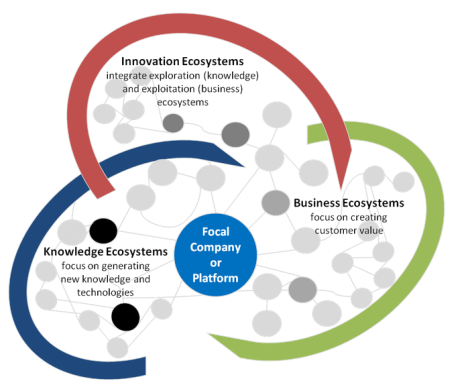
Now I relate very strongly to different visuals and this happens to be a current favorite of mine. It sums up the differences between the types of ecosystems we need to recognize and work through.
I came across this in a paper by Katri Valkokari, a Research Manager at VTT Technical Research Centre of Finland in the Business, Innovation and Foresight research area.
Although it presses a number of buttons for me, the paper seems to have limited the differences shown here and I just want to throw this visual open just a little more, in your ‘need to know’ here and then come back to it later.
What Katri does, is provide a really good contribution into how they differ in outcomes, interactions, even a logic of actions and the different ‘actor’ roles for the three.
A return to thinking Ecosystems and Platforms
So after a short hiatus after Jeffrey’s great summary “Recapping our ecosystem and platform thoughts” I have struggled a little to get back into this area. I have to admit I was a little bit deflected into other innovation thoughts that are now moving along. It is equally not because I lack many different thoughts or contributions on Ecosystems and Platforms, it simply was that ‘breaks’ sometimes force a ‘layoff’ in your engagement levels and then requires a little more discipline to ‘get back into it’.
So to ease my way back into this, I wanted to get back firstly into why Ecosystems “speak to me” and this visual above just does a great job in depicting the potentials we can find within ecosystem thinking. It covers the three essential points within an ecosystem to work through.
The differences between the three ecosystems
Katri offers the following differences in that Business ecosystems focus on present customer value creation, and the large companies are typical key players within them. Knowledge ecosystems focus on the generation of new knowledge, and in this way research institutes and innovators, such as technology entrepreneurs, play a central role in these ecosystems. Innovation ecosystems occur as an integrating mechanism between the exploration of new knowledge and its exploitation for value co-creation in business ecosystems.
I am not so sure Business Ecosystem are only placed in the ‘present’ on customer value creation, I think they evolve as they build mutually, reinforcing each other as all those involved learn from each other in their exchange for the future because of their dependencies. Katri rightly points out all these ecosystems are dynamic, changing and also changeable through ecosystem orchestration to keep the ecosystem balanced as it is dynamic in the constant as it should induce both competition and cooperation that promotes ongoing adapting.
I like her linking into a platform as well, “the shared platform acts as the locus of coordination and influence the ecosystem evolution”.
Where she concludes is raising the point this interaction between the different types of ecosystems is an unexplored area and while she is perhaps right, I might suggest they are ONE and she has just separated the parts. We are needing to work through all three ecosystems of acquiring knowledge, integrating this through new innovation and then generating the customer value. I feel this covers the three-step process of ecosystem evolution. What do you think?
The three ecosystems suggested are in my view needed to be fused into one
So for me, it is a great visual of the three parts of an ecosystem that actually should be fused into one, the integrated ecosystem, that ensures that its three distinct parts are worked through, certainly with different mindsets and needs. How you work through the differences and logic Katri attempts an opening construct and I certainly think this can be broadened out further. My view is, you take the three parts of a needed ecosystem shown in this great visual and then build the ‘whole’ from its connected parts.
A further post will come on this to build this further out
A post along the way will attempt to deepen this but for the moment I just wanted to provide this great visual (well for me) and to begin to get back into constructing ecosystems and platform thinking.
To finish on the final comment in Jeffrey’s recent post: “As we continue to outline our thinking, we’ll be working on the more practical implications of innovating in a platform and ecosystem world, moving from theoretical to more operational and practical”.
We hope you’ll continue the journey with us”
I agree. I like Valkokari’s work distinguishing between the three ecosystems, but businesses need to be an integrated “whole” rather than a collection of siloed departments. Frequently I see large companies fail at driving innovative thinking because they quarter it off to a single “skunk works” department that quickly loses touch with the customer or ongoing business knowledge development. Sectioning off innovation frequently results in a room full of researchers developing solutions for non-existing problems. Instead, the top performing firms seem to ask every employee to adopt all three of the mindsets by directing their behavior towards developing knowledge, setting their focus on increasing customer value, and empowering employees to innovate and experiment towards these goals. Anyway, I look forward to reading more in your upcoming posts.
Thanks Casey for your thoughts and observations. Yes it needs integrating as a whole as we both agree. It is this that needs the further focus.
say thanks to a lot for your web site it helps a lot. http://www.asas.or.id/anggota/bernard47l5208/